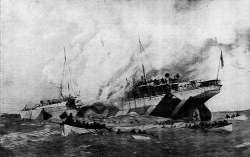
TODAY in Irish History - 1918 On this day 100 years ago, the Dún Laoghaire to Holyhead mailboat 'RMS Leinster' was torpedoed and sunk by a German U-boat just outside of Dublin Bay. The sinking has largely been forgotten but was the worst ever Irish Sea disaster. Shortly before 9am, October 10th, 1918 the RMS Leinster left Carlisle Pier, Kingstown (now Dun Laoghaire), Dublin, bound for Holyhead, Wales. The ship carried 771 passengers and crew. The ship was commanded by Captain William Birch (61), a Dubliner who had settled with his family in Holyhead. Apart from Birch, the Leinster had a crew of 76, drawn from the ports of Dun Laoghaire and Holyhead. Also on board were 22 postal sorters from the Dublin Post Office, working in the ship's onboard postal sorting room. There were 180 civilian passengers, men, women and children, most of them from Ireland and Britain. The greatest number of passengers on board the Leinster were military personnel. Many of them were going on leave or returning from leave. They came from Ireland, Britain, Canada, the United States, New Zealand and Australia. On the Western Front the German Army was being pushed back by the relentless assaults of the Allied armies. On 4 October Germany had asked US President Woodrow Wilson for peace terms. As the Leinster set sail from Dún Laoghaire the weather was fine, but the sea was rough following recent storms. Earlier that morning a number of Royal Navy ships at sea off Holyhead were forced to return to port due to the stormy conditions. Shortly before 10am just 16 miles from Dun Laoghaire a few people on the deck of the Leinster saw a torpedo approaching the port (left) side of the ship. It narrowly missed the Leinster, passing in front of her. Soon afterwards another torpedo struck the port side where the postal sorting room was located. Postal Sorter John Higgins said that the torpedo exploded, blowing a huge hole in the port side. The explosion traveled across the ship, also blowing a whole in the starboard side. In a desperate attempt to return to Dún Laoghaire, the Leinster turned 180 degrees, until it faced the direction from which it had come. With speed reduced and slowly sinking, the ship had sustained few casualties. Lifeboats were being launched. At this point a second torpedo struck the ship on the starboard (right) side, practically blowing it to pieces. The Leinster sank rapidly, bow first. Many of those on board were killed in the sinking. In lifeboats or clinging to rafts and flotsam, the survivors now began a grim struggle for survival in the rough sea. Many died while awaiting rescue. Eventually a number of destroyers and other ships arrived. The survivors were landed at Dun Laoghaire where the ferry terminal now stands. Doctors, nurses, rescue workers and a fleet of 200 ambulances rushed to Victoria Wharf. Those needing medical care were brought to St. Michael's Hospital in Dun Laoghaire and several Dublin Hospitals. Those not requiring medical treatment were brought to local hotels and guest houses. In the days that followed bodies were recovered from the sea. Funerals took place in many parts of Ireland. Some bodies were brought to Britain, Canada and the United States for burial. 144 military casualties were buried in Grangegorman Military Cemetery in Dublin. Research to date has revealed the names of 529 casualties making it the greatest ever loss of life in the Irish sea and the highest ever casualty rate on an Irish owned ship.



